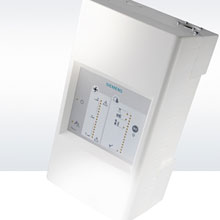 |
|
The smoke detectors function reliably even under harsh detection conditions and provide early fire detection |
The Siemens Building Technologies Division has introduced two aspirating smoke detectors which can distinguish between smoke, steam and dust. The detector models FDA221 and FDA241 function reliably even under harsh detection conditions and provide early fire detection.
Aspirating smoke detectors (ASD) continuously take air using an air sampling pipe network from the detection area and analyse the air for smoke particles. However, conventional models do a poor job of distinguishing between dust and smoke and are therefore susceptible to false alarms. The Siemens Building Technologies Division solves this problem with its new ASD models, FDA221 and FDA241. Both devices are based on optical dual-wavelength detection technology, which uses blue and infrared light waves. Based on different light wavelengths, the detectors can determine the size and concentration of particles and thus distinguish between smoke and dust. As a result, they are largely immune to external interference. Siemens offers its well-known Genuine Alarm Guarantee for these new aspirating smoke detectors.
Model FDA221 covers an area of up to 500 square meters with a programmable sensitivity of 0.2 to 20%/m. FDA241 monitors up to 800 square meters with a sensitivity of 0.03 to 20%/m. The FDA241 model provides three presettable modes – "ultrasensitive," "auto-discrimination," and "robust," – and supports the programming of custom alarm thresholds. In addition, FDA241 has a programmable purge function in the event it senses pipe contamination, and also a programmable 4-20mA output, which can be used to output a variety of information, such as smoke, airflow rate, dust or fine dust concentrations. To keep maintenance costs low, the two detectors are built around a patented detection chamber which minimises internal soiling.
The new aspirating smoke detectors are easy to install and can be integrated into an existing Siemens fire detection system, such as Sinteso, using FDnet. The integration ensures full transparency regarding message display and operation. This makes it possible to configure the detectors, perform maintenance work and handle alarm and fault management right on the fire control panel, thereby optimising control and lowering the cost of the overall solution.
Both detectors are particularly suitable for use in locations where harsh detection conditions prevail, where an esthetically appealing solution is desired or high detection sensitivity is required. This is the case, for example, in large spaces such as lobbies, warehouses and industrial production areas, in hard-to-access areas such as cable ducts and subway tunnels as well as in data centers and clean rooms.




